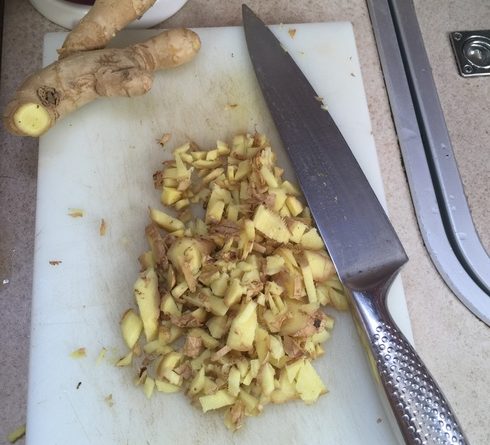Brewing ginger beer on a boat
Brewing ginger beer on a boat is a lot easier that you think and the end result is absolutely delicious. The time how long you let it brew and how much sugar you put in, will dictate the strength. The recipe for the below produces a batch that is not terribly strong.
Brewing ginger beer on a boat is simple
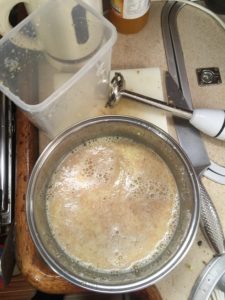
What you will need to make delicious ginger beer:
- Fresh ginger root (you can use powdered ginger but it will result in more sediment when you filter it)
- Bag of raisins (you’ll need about 2 handfuls)
- Bread yeast (or wine yeast – if you have the fancy stuff – but plain old bread yeast will do)
- Malic or tartaric acid (this enhances and sharpens up the flavor)
- 300 to 400 grams of sugar
- 5 liters of water and a 5 liter water bottle
- Grater or hand blender
- A few empty PET bottles (i.e. fizzy soft drink bottles designed for carbonated drinks or soda water)
Brewing ginger beer on a boat – here’s how:
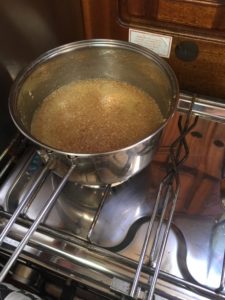
The amount of root you use will dictate the amount of gingery fire you will get from your ginger beer. Either finely grate your ginger using the raspy part of the grater or finely chop it, then add some water and give it a quick blitz with a hand blender.
Add a cup or two of water and bring your mix to the boil on the stove. No need to simmer, just bring it up to the boil to steep and encourage the flavor out.
Next add 300 to 400 grams sugar and 1 teaspoon of tartaric or malic acid. You could substitute the juice of two lemons in place of the acid however this is not quite as tasty.
Stir your mixture up until the sugar dissolves. Once all mixed in nicely, add a little more water to cool off the solution and pour it all into a 5 liter container.
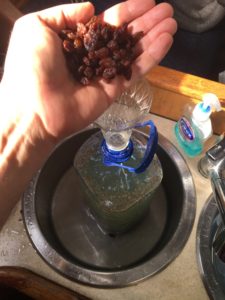
Fill the container with fresh water to about 9/10 full, leaving space for the raisins and some room for froth as the brew may get a little frothy. Add to the mixture two large hand fulls of raisins and 1 teaspoon of bread or wine yeast.
Now you can close up the bottle and give it a quick shake to mix everything up and your ginger beer is ready to start brewing.
Brewing ginger beer on a boat – the brewing process
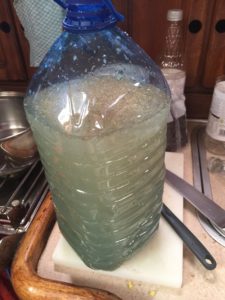
An important note to remember before you stick the bottle in a dark place to fizz away, is to loosen the lid.
The yeast you added, starts to feed off the sugars in the mix and the byproduct is alcohol and carbon dioxide. You’ll see bubbles start to form quite soon. If you leave the lid on, you’ll have a bang and either the lid will pop off or the bottle will split and you’ll have your bilge smelling of ginger beer… which may well be an improvement.
Either loosen the lid and leave it on to keep bugs out or remove the lid and tie a wash cloth over the top.
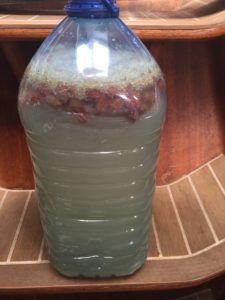
I prefer the loose lid approach as I give the bottle a shake every now and then when I pass it and the lid keeps things clean. Just remember to loosen it again when done.
You can now leave your ginger beer brewing for anything from 1 to 5 days to fizz away. The longer you leave it, the more sugar will be converted into alcohol. So if you prefer a sweeter, lighter drink then 1 day will be enough before bottling. If you leave it a few days you’ll get a stronger, less sweet mix. In that case you can always add more sugar or syrup at the bottling stage.
Brewing ginger beer on a boat – bottling
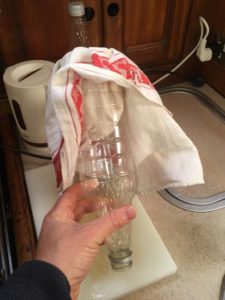
When you’re ready to bottle your ginger beer, you need to filter out the bits – no one wants a mouth full of raisins or ginger pulp! Either use a funnel (not the one for oil changes) or make one yourself with an old squash bottle and use a clean tea towel to filter out the bits as you transfer your ginger beer into your soda bottles.
At this point your brew should taste delicious and have a small amount of fizz. Bottling it will give it much more fizz as it will be finishing off under pressure. For this reason DON’T use glass bottles to bottle your beer unless they are specifically designed to handle live brews under pressure. If they don’t, they can explode. Aside from the mess this will create, exploding glass bottles can be rather dangerous.
Filter and decant your beer into plastic PET soda bottles and store ready to drink. If you have let your mash brew for a few days you can add more sugar to taste. You’ll notice when squeezing the bottles that after a few hours they will pressurise. The best approach is to leave them in a dark place for a few hours to get some pressure, then stow them in the fridge. This will slow the fermentation down a little and make for a lovely ice cold beverage.
Happy brewing.

